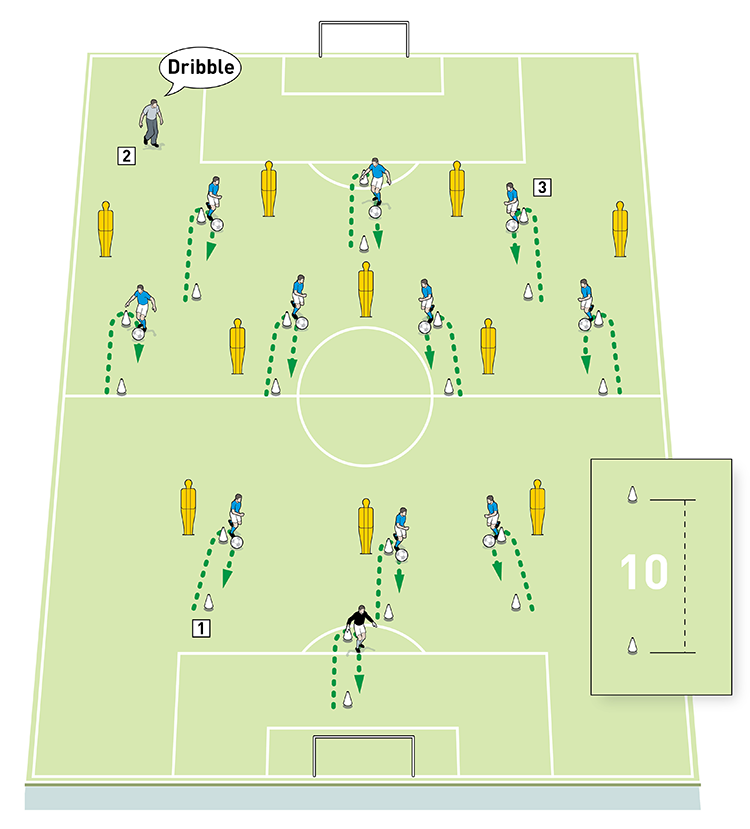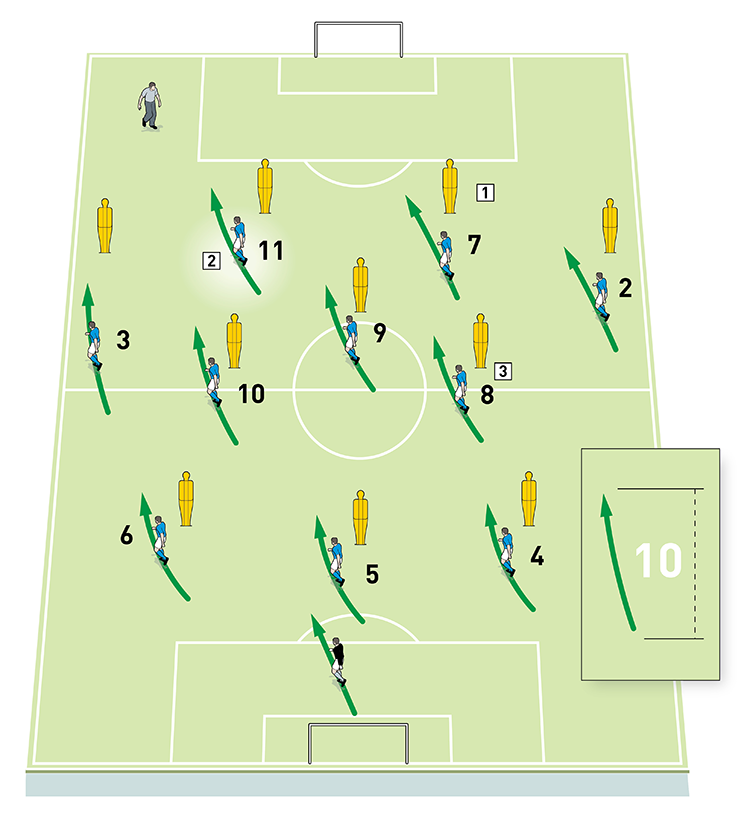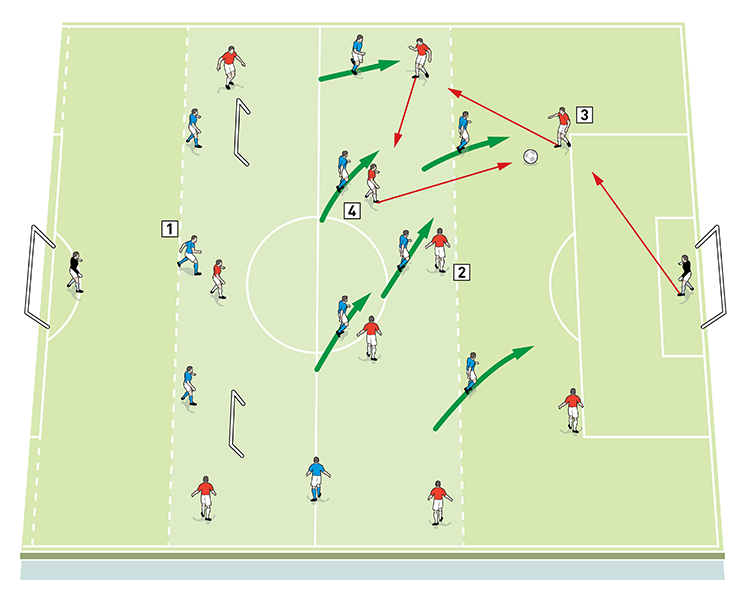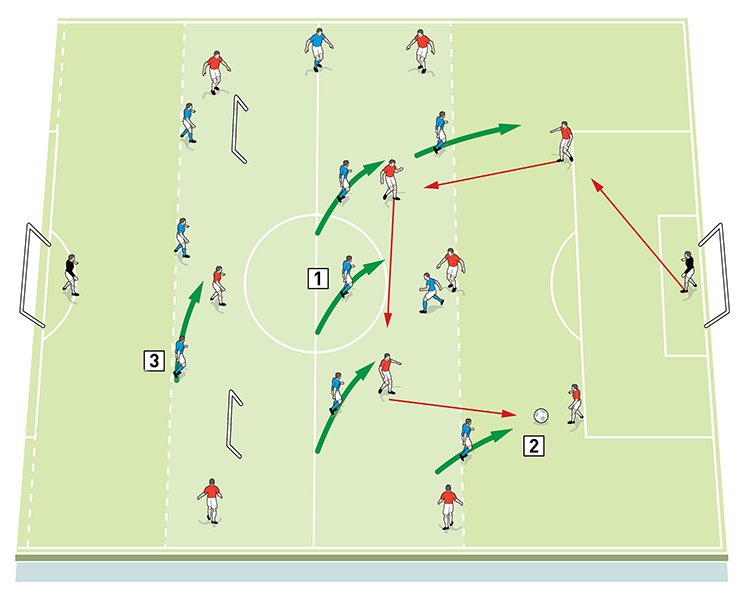




OUR BEST EVER OFFER - SAVE £100/$100
JOIN THE WORLD'S LEADING PROFESSIONAL DEVELOPMENT PROGRAMME
- 12 months membership of Elite Soccer
- Print copy of Elite Player & Coach Development
- Print copy of The Training Ground
Defensive organisation playing 3-4-3
This session is all about defensive organisation when playing in a 3-4-3. More specifically, it is focused on pressing in the middle third of the pitch. It teaches players when to press, who triggers the press and how the team should support the press. It also encourages the team to maintain a compact and narrow defensive shape.
| Area | Full size pitch |
| Equipment | Balls, bibs, cones, 10 mannequins, 2 small goals, 2 full size goals |
| No. of Players | Up to 20 players + 2 goalkeepers |
| Session Time |
Warm-up: 20mins, Defending the midfield: 30mins |
This session is all about defensive organisation when playing in a 3-4-3. More specifically, it is focused on pressing in the middle third of the pitch. It teaches players when to press, who triggers the press and how the team should support the press. It also encourages the team to maintain a compact and narrow defensive shape.
It works because it makes teams very organised and creates a sense of togetherness when winning possession. It also encourages communication between players.
What do I get the players to do?
Warm-up
We set up on a full size pitch. We’re using 10 outfield players and a goalkeeper. The players line up in a 3-4-3 formation on the pitch, with the goalkeeper in his usual position.
Each player has a cone marking his starting position and a second cone 10 yards in front. Each player has a ball. Set out 10 mannequins to represent the opposition, lined up in a 4-3-3 formation.
On the coach’s command, all players dribble from their starting cone to the cone 10 yards ahead of them, as shown [1a]. They then turn and dribble back. We can advance the warm-up by instructing all players to arrive at the cones at the same time – to achieve this, they must keep their heads up so they can see the movements of their team mates. They should also communicate with each other to make sure they arrive at the same time.
1a

2. On the coach’s command, players dribble to the cone 10 yards ahead of them and then turn and dribble back
3. Once they are used to the movement, ask players to arrive at the cones at the same time. To do this they keep their heads up and should communicate
Next, we get the players to leave the ball and sprint to the next cone, with them all arriving together. We then get them to run backwards to the first cone.
How do I progress the
warm-up?
Using the same basic set-up with the mannequins still in place, we remove the cones and the balls. The number 11 presses to the left of the mannequin in front of him (the mannequin that represents the right-sided central defender). The rest of the team follow suit and press to the left of the mannequin in front of them, as shown [1b]. Each player must press 10 yards forwards.
1b

2. The number 11 presses to the left of the mannequin in front of him
3. The rest of the team follow suit and press to the left of the mannequin in front of them. Each player must press 10 yards forwards
sWe then repeat, this time instructing the number 7 to press to the right of the mannequin in front of him (the mannequin that represents the left-sided central defender), with his team mates then supporting in the same manner by pressing 10 yards forward to the right of their mannequin.
What do I get the players to do next?
Defending the midfield
We set up on three quarters of the pitch with a goal at each end. We also position two small goals on the short side of the pitch. We mark out a midfield zone of 40 yards spanning either side of the halfway line, where the midfield press takes place.
We’re using 20 outfield players and two goalkeepers, split into two teams of 11. We coach the team playing 3-4-3 (the blues) and they defend the three goals at the short end of the pitch. The opposition (the reds) line up in a 4-3-3 formation. All the outfield players start in the midfield zone, except the two central defenders of the red 4-3-3 team. The blues are set up in compact and narrow starting positions.
Play starts with a pass out from the goalkeeper of the red team to his central defenders, who pass the ball across the back line and look to break down the 3-4-3 system of the blues.
The blues should try to force the opposition to pass backwards and continue the press in central and wide areas, as shown [2a/2b]. If the press fails, the red 4-3-3 team can score in either the small goals or attack the normal sized goal, as shown [2c]. Normal offside rules apply.
2a

2. Most of the outfield players start in the midfield zone
3. Two central defenders on the red 4-3-3 team start play in their defensive zone by receiving from their keeper and building an attack
4. The blues press to force the reds to pass backwards. The blue wing back presses the opposition full back and here his team mates shift across to support the press, forcing the reds back
2b

2. The strikers should press high into the final third too, trying to force the defenders to pass back to the keeper
3. The blues should keep a compact shape wherever they are on the pitch, with all players keeping the same distance between each other
2c

As soon as the blue defending team gains possession they should clear it out of the area and the opposition keeper would feed another ball into his defenders which helps to continue the flow of the game and works the team physically.
What are the key things to look out for?
For the blue 3-4-3 team, we want to see the wing back pressing the opposition full back when he’s on the ball and then the blue team should support the press, with all the players moving across and leaving space on the opposite side of pitch.
We want to see the defending team keeping organised, with the distance between each player kept the same – they should maintain a compact and narrow shape. If the opposition are forced back, the blue press should continue with the strikers putting pressure on the ball. If the ball is passed back to the goalkeeper, the striker has a decision to make and should press if he thinks he can affect the keeper’s first touch.
Most importantly, we want to see the defending team keeping a compact shape wherever they are positioned on the pitch.
What are the typical mistakes players might make and how do I avoid them?
Players aren’t certain when to press and can sometimes be late. We can control the pressing player by blowing the whistle as a signal to press.
Sometimes we see players on the opposite side of the pitch starting to switch off. To remedy this, we stop and coach them, particularly if they are too far apart or if the distance between players is too wide.
The back three can also stay too deep if they are not encouraged to move up when good pressing is applied.
Related Files
Editor's Picks
Attacking transitions
Deep runs in the final third
Using the goalkeeper in build-up play
Intensive boxes drill with goals
Penetrating the final third
Creating and finishing
My philosophy
Pressing initiation
Compact team movement
Coaches' Testimonials

Alan Pardew

Arsène Wenger

Brendan Rodgers

Carlos Carvalhal

José Mourinho

Jürgen Klopp

Pep Guardiola

Roy Hodgson

Sir Alex Ferguson

Steven Gerrard
Coaches' Testimonials

Gerald Kearney, Downtown Las Vegas Soccer Club

Paul Butler, Florida, USA

Rick Shields, Springboro, USA

Tony Green, Pierrefonds Titans, Quebec, Canada
Join the world's leading coaches and managers and discover for yourself one of the best kept secrets in coaching. No other training tool on the planet is written or read by the calibre of names you’ll find in Elite Soccer.
In a recent survey 92% of subscribers said Elite Soccer makes them more confident, 89% said it makes them a more effective coach and 91% said it makes them more inspired.
Get Monthly Inspiration
All the latest techniques and approaches
Since 2010 Elite Soccer has given subscribers exclusive insight into the training ground practices of the world’s best coaches. Published in partnership with the League Managers Association we have unparalleled access to the leading lights in the English leagues, as well as a host of international managers.
Elite Soccer exclusively features sessions written by the coaches themselves. There are no observed sessions and no sessions “in the style of”, just first-hand advice delivered direct to you from the coach.








